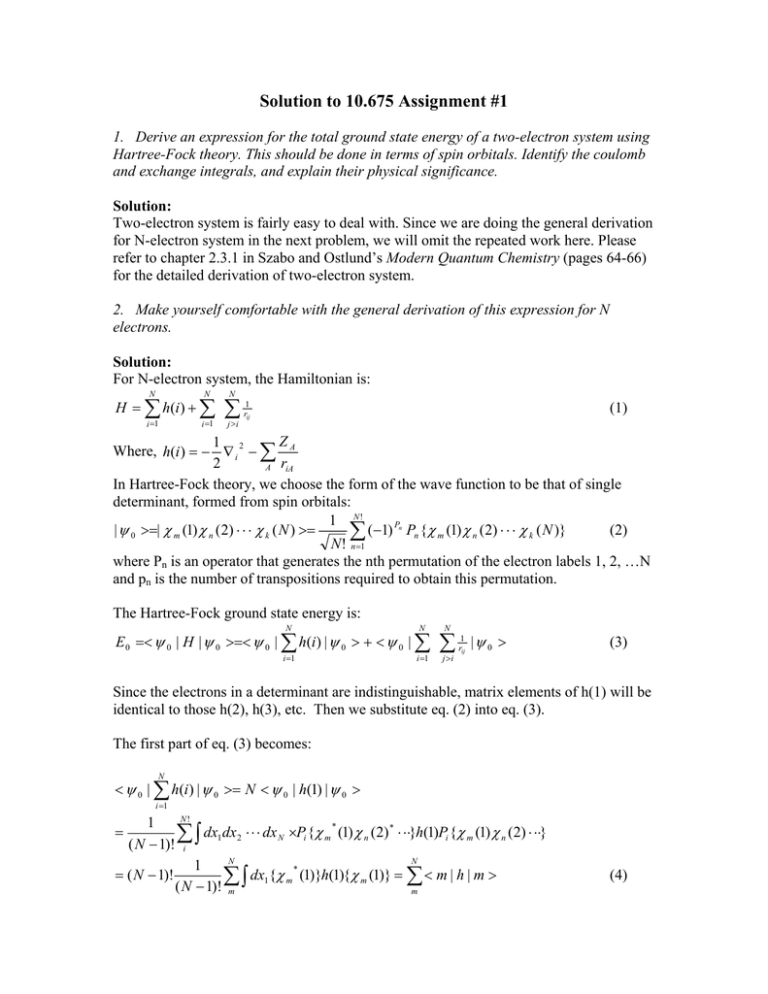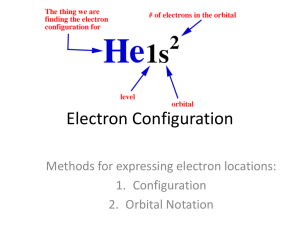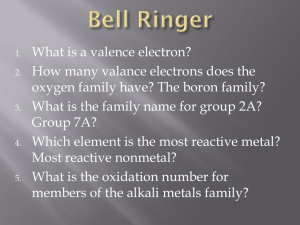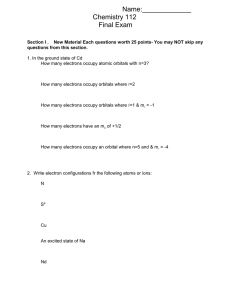Solution to 10.675 Assignment #1
advertisement

Solution to 10.675 Assignment #1
1. Derive an expression for the total ground state energy of a two-electron system using
Hartree-Fock theory. This should be done in terms of spin orbitals. Identify the coulomb
and exchange integrals, and explain their physical significance.
Solution:
Two-electron system is fairly easy to deal with. Since we are doing the general derivation
for N-electron system in the next problem, we will omit the repeated work here. Please
refer to chapter 2.3.1 in Szabo and Ostlund’s Modern Quantum Chemistry (pages 64-66)
for the detailed derivation of two-electron system.
2. Make yourself comfortable with the general derivation of this expression for N
electrons.
Solution:
For N-electron system, the Hamiltonian is:
N
N
H = ∑ h(i) + ∑
i=1
i=1
N
∑
j >i
(1)
1
rij
Z
1 2
Where, h(
i ) = − ∇ i − ∑ A
2
A riA
In Hartree-Fock theory, we choose the form of the wave function to be that of single
determinant, formed from spin orbitals:
1 N!
| ψ 0 >=| χ m (1) χ n (2) ⋅ ⋅ ⋅ χ k (N ) >=
(−1) Pn Pn {χ m (1) χ n (2) ⋅ ⋅ ⋅ χ k (N )}
(2)
∑
N! n=1
where Pn is an operator that generates the nth permutation of the electron labels 1, 2, …N
and pn is the number of transpositions required to obtain this permutation.
The Hartree-Fock ground state energy is:
N
N
E 0 =< ψ 0 | H | ψ 0 >=< ψ 0 | ∑ h(i ) | ψ 0 > + < ψ 0 | ∑
i =1
i =1
N
∑
j >i
1
rij
|ψ 0 >
(3)
Since the electrons in a determinant are indistinguishable, matrix elements of h(1) will be
identical to those h(2), h(3), etc. Then we substitute eq. (2) into eq. (3).
The first part of eq. (3) becomes:
N
< ψ 0 | ∑ h(i ) | ψ 0 >= N < ψ 0 | h(1) | ψ 0
>
i =1
N!
1
*
=
dx1 dx 2 ⋅ ⋅ ⋅ dx N ×Pi {χ m (1) χ n (2) * ⋅ ⋅⋅}h(1)Pi {χ m (1) χ n (2) ⋅ ⋅⋅}
∑
∫
(N − 1)! i
N
N
1
*
= (N − 1)!
dx
{
χ
(
1
)}
h(1){
χ
(
1
)}
=
∑ 1 m
∑m < m | h | m >
m
(N − 1)! m ∫
(4)
[Note: The reason that (N-1)! factor was added in the next to the last step is that in the
sum over the N! permutations, electron 1 will occupy each of the spin orbitals (N-1)!
times. And the integration over the other N-1 electrons will always give a factor of 1
since the spin orbitals are normalized.]
Similarly, we can get the second part of eq. (3):
N
N
<ψ 0 | ∑
∑
i =1
j >i
1
rij
| ψ 0 >=
(5)
1
N ( N − 1) 1 N ! N !
P
*
(−1) Pi (−1) j ∫ dx1 dx 2 ⋅ ⋅ ⋅ dx N ×Pi {χ m (1) χ n (2) * ⋅ ⋅⋅} Pj {χ m (1) χ n (2) ⋅ ⋅⋅}
∑
∑
2
N! i
r12
j
Because the operator in eq. (5) involves only electrons 1 and 2, it must be that other
electrons occupy the same spin orbitals in both the ith and jth permutations, or we could
get zero by orthogonality upon integrating over the coordinates of these electrons. If
electrons 3, 4,…,N occupy the same spin orbitals in the two permutations and electrons 1
and 2 occupy two spin orbitals, say χk and χl in the permutation Pi, then there are two
possibilities for electrons 1 and 2 in the permutation Pj: They could either occupy the
same spin orbitals χk and χl (same as Pi) or they could occupy χl and χk.
Therefore, we can write eq. (5) as:
N!
1
1
*
dx1 dx 2 ⋅ ⋅ ⋅ dx N ×Pi {χ m (1) χ n (2) * ⋅ ⋅⋅} [Pi {χ m (1) χ n (2) ⋅ ⋅⋅} − P12 Pi {χ m (1) χ n (2) ⋅ ⋅⋅}]
∑
∫
2(N − 2)! i
r12
For a reason similar to that in the first part, in the sum of N! permutations, Pi, electrons 1
and 2 can occupy any two different spin orbitals χm and χn of the set of N spin orbitals.
For each choice of these two spin orbitals there are (N-2)! Ways of permuting the other
N-2 electrons among the N-2 remaining spin orbitals. Therefore, eq. (5) can be written as:
N
N
<ψ0 | ∑
∑
j >i
i=1
=
=
=
(N − 2)!
∑
2(N − 2)! m
N
N
1
∑
2 m
N
1
∑
2 m
|ψ 0 >
1
rij
N
∑ ∫ dx dx {χ
1
n≠m
N
∑ ∫ dx dx {χ
n≠m
1
2
*
m
2
*
m
(1) χ n (2) * }
(1) χ n (2) * }
1
(1 − P12 ){χ m (1) χ n (2)}
r12
1
[{χ m (1) χ n (2)} − {χ m (2) χ n
(1)}]
r12
N
∑ < mn | mn > − < mn | nm >
(6)
n≠m
Combine eqs. (3) (4) and (6), we get:
N
E0 =< ψ 0 | H | ψ 0 >= ∑ < m | h | m > +
m
N
N
m
m
= ∑< m | h | m > + ∑
1 N
∑
2 m
N
∑ < mn | mn > − < mn | nm >
n≠m
N
∑ < mn | mn > − < mn | nm >
m>n
(7)
For two-electron system, | ψ 0 >=| χ 1 (1) χ 2 (2) >
N
N
m
m
E0 = ∑ < m | h | m > + ∑
(m=1, n=2 here), eq. 7 becomes:
N
∑ < mn | mn > − < mn | nm >
m>n
=< 1 | h | 1 > + < 2 | h | 2 > + < 12 | 12 > − < 12 | 21 >
(8)
where <12|12> is the Coulomb integral, which represents the classical Coulomb repulsion
between the charge clouds |ψ1(x1)|2 and |ψ2(x2)|2; <12|21> is the exchange integral. The
appearance of exchange integrals in the energy of a Slater determinant is a manifestation
of the fact that the motion of electrons with parallel spins is also correlated.





